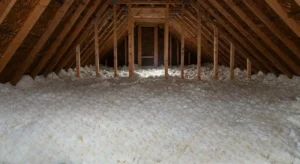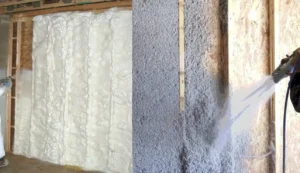At Flatland Roofing & Insulation, we hear it all the time: “I want my home to feel better—and cost less to run.” The question is how to get there. Blown-in insulation is one of the most overlooked answers. It’s not flashy, but it works and it works exceptionally well when installed and maintained the right way. Homeowners in the Texas Panhandle trust us because we don’t oversell or cut corners. We deliver what actually helps. And when it comes to lasting comfort and lower bills, blown-in insulation gets the job done.
In this guide, we’re cutting straight to what matters. We’ll explain exactly why blown-in insulation can change the feel and the cost of your home, how it compares to other options, and why it’s a smart choice for both new builds and older homes. We’re giving you the insight we use on every job. And when you’re ready to make your home more efficient, we’re here to help.
Lower Utility Bills Without Sacrificing Comfort
Heating and cooling costs in Texas aren’t something you want to gamble with. The wrong insulation choice will leave you paying more just to keep your home livable. Blown-in insulation offers consistent coverage that fills every gap, cutting out the leaks that traditional materials miss.
A homeowner in Amarillo came to us with one room that was always hotter than the others in summer. After installing blown-in cellulose insulation, that temperature difference dropped almost immediately. Within the first month, they saw a 20% decrease in their energy bill.
Blown-in insulation keeps conditioned air where it belongs. That translates into fewer system cycles, reduced strain on HVAC units, and real monthly savings that add up over time.
Energy Efficiency and Insulation Coverage Go Hand-in-Hand
Unlike batt insulation that often leaves small gaps and voids especially in irregularly shaped cavities—blown-in material settles into every corner. That full coverage reduces thermal bridging, which means you lose less heat in winter and less cool air in summer.
We use dense-pack cellulose and fiberglass options depending on your building type, moisture environment, and airflow needs. Every solution is matched to the job, and every application is performed by professionals who know the science, not just the tools.
Blown-In Insulation Delivers Long-Term HVAC Relief
Less heat loss means less furnace runtime. Less cool air escaping means your AC doesn’t have to work as hard. Over time, this makes a measurable difference in system lifespan. We’ve had clients report fewer maintenance calls and even delay system replacements—just from better insulation. If you want to protect your HVAC investment, start by reducing its workload.
More Comfortable Living Year-Round
One of the biggest frustrations we hear from homeowners is uneven temperatures across different rooms. Some spaces are too warm, others too cold. Poor insulation—or insulation that’s settled or degraded is usually the root cause.
Blown-in insulation solves this by conforming to the space, no matter how irregular the walls or attic might be. It fills in around wiring, piping, and framing where heat transfer loves to happen.
Attic Insulation Plays a Major Role in Interior Comfort
Attics are often the biggest source of heat gain or loss in a home. Hot air rises, and without proper attic insulation, it escapes fast in winter or turns your home into a furnace in summer. Blown-in insulation applied to attic floors creates a thick, seamless thermal layer that blocks this energy flow.
After retrofitting an older Lubbock home with attic insulation, the homeowner told us it was the first time in years they didn’t need to run fans just to stay cool.
Blown-In Works with Existing Structures
You don’t need to tear out walls to get better insulation. For older homes or remodels, blown-in material can be inserted through small openings in the wall cavity. This makes it a powerful tool for improving comfort without disruptive construction.
We’ve worked on countless homes where homeowners didn’t want major renovations but they still wanted results. Blown-in insulation allowed us to give them both.
Cost-Effective Installation With Minimal Disruption
Time, labor, and material costs are major considerations when it comes to home upgrades. Blown-in insulation offers an efficient installation process that doesn’t require full demolition or structural changes. That means lower upfront costs and less disruption to your home.
On a recent job in Plainview, we completed a full attic insulation project in less than a day and the homeowners were able to sleep in comfort that same night. No delays, no stress, and no mess.
Retrofitting Is Fast and Clean
The ability to install blown-in insulation through small access points reduces cleanup and disruption. We use professional-grade equipment that contains dust and ensures uniform application. Our crew is trained to respect your space, clean as we go, and get the job done right the first time.
Competitive Pricing Without Cutting Corners
Some companies quote low prices by skimping on material density or coverage. We don’t. Our pricing reflects what it takes to do the job properly. That means you get a full fill, proper settling adjustments, and no gaps in performance.
Over the years, we’ve seen the difference between rushed installs and quality work and our customers feel that difference in their homes every day.
Better Indoor Air Quality and Noise Control
Blown-in insulation doesn’t just regulate temperature it contributes to a quieter, healthier indoor environment. That’s especially important for families dealing with allergies, outside noise, or nearby construction.
Cellulose options are particularly effective at reducing airborne sound, and they can help trap dust and pollen from circulating. In multi-family units or homes near busy streets, this benefit is hard to overstate.
Air Sealing Reduces Dust and Drafts
When blown-in insulation is paired with targeted air sealing, the results are substantial. We use sealants and barriers at critical leakage points before applying insulation, which helps keep outside contaminants out and interior air more stable.
The result is fewer drafts, less dust settling on furniture, and cleaner air for everyone inside.
Quieter Spaces for Work and Rest
Noise from outside whether it’s traffic, barking dogs, or loud neighbors can make your home feel less peaceful. Blown-in insulation dampens these sounds by filling wall cavities more completely than batts, reducing vibration and noise transmission.
Your Home Could Feel Better Starting Now
Blown-in insulation isn’t just another home upgrade. It’s a direct path to a quieter, more comfortable home that costs less to maintain. At Flatland Roofing & Insulation, we’ve seen firsthand what a difference it makes.
If you’re tired of high utility bills, inconsistent comfort, or noisy rooms, this is your opportunity to fix it without a major renovation. We bring the knowledge, materials, and workmanship to make your home more efficient, starting with the insulation that powers everything else.
You don’t have to guess. You don’t have to wait.
Call Flatland Roofing & Insulation at (806) 606-6794 or email us at info@flatlandroofcoatings.com to schedule an evaluation. Let’s get your home working better for you—one room at a time.
Have More Questions? We’ve Got Answers
What is blown-in insulation made of?
We offer two main types: cellulose, which is recycled paper treated for fire resistance, and fiberglass, which is made from fine glass fibers. Both offer high performance, and we help you choose the right one based on your home’s needs.
How long does blown-in insulation last?
Properly installed, it can last 20 to 30 years or more. It doesn’t degrade quickly, and we apply it at densities that help prevent settling and sagging over time.
Will blown-in insulation lower my energy bills?
Yes. Most homeowners see significant energy savings often 15% to 30% depending on the condition of the home before installation.
Can blown-in insulation be installed in existing walls?
Yes. We drill small holes in the wall cavity, fill the space with insulation, then patch the area. It’s fast, minimally invasive, and very effective.
Is it safe for people with allergies?
We use insulation materials that are non-toxic, low-VOC, and safe for indoor air. Cellulose even helps reduce airborne allergens.
How long does installation take?
Most projects take less than a day. Attic installs can often be completed in just a few hours, depending on access and square footage.
What’s the difference between cellulose and fiberglass?
Cellulose tends to be denser and offers better soundproofing. Fiberglass is lighter and has excellent thermal resistance. Both perform well, and we help you choose based on application.
Will it settle over time?
Some settling is normal, but we account for that in our application process. We install at the correct density to ensure long-term effectiveness.
Can blown-in insulation help with soundproofing?
Yes. It significantly reduces airborne noise between rooms and from outside sources.
How do I know if my insulation needs upgrading?
If you have uneven temperatures, high bills, or drafty rooms, it’s probably time to reassess. We offer insulation assessments to give you clear answers.




